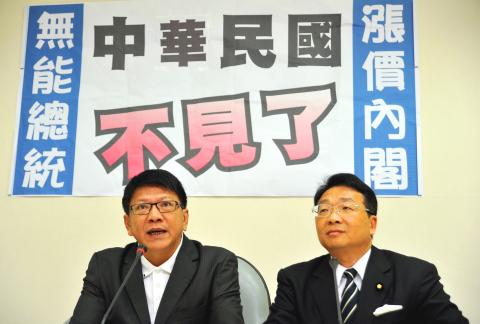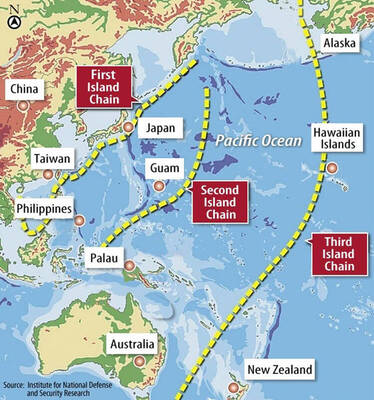The pan-green camp yesterday lashed out at former Chinese Nationalist Party (KMT) chairman Wu Poh-hsiung’s (吳伯雄) “one country, two areas (一國兩區)” comments while meeting Chinese President Hu Jintao (胡錦濤) in Beijing on Thursday, saying it was a virtual elimination of the Republic of China (ROC) and an ill-intentioned step toward unification.
Wu met Hu in Beijing at the annual forum between the KMT and the Chinese Communist Party, during which he proposed that cross-strait matters be tackled using a “one country, two areas” formula.
Taiwan’s current cross-strait policy is based on the Act Governing Relations Between the Peoples of the Taiwan Area and the Mainland Area (台灣地區與大陸地區人民關係條例), which Wu said has “one country, two areas” as its legal basis.

Photo: Chien Jung-fong, Taipei Times
The Democratic Progressive Party (DPP) said the initiative has taken the KMT’s previous position of “one China, with different interpretations” a step further, acknowledging that both sides of the Taiwan Strait belong to “one country.”
“The DPP has always maintained that Taiwan is a sovereign country with the name the Republic of China and that any change in the ‘status quo’ must be decided by the Taiwanese people,” DPP spokesperson Lo Chih-cheng (羅致政) told a press conference.
President Ma Ying-jeou (馬英九), who doubles as KMT chairman, should explain whether he authorized Wu to submit the initiative and whether he agrees with the proposal, Lo said.
The most detrimental impact of was not self-belittlement, but the “implication that both sides of the Taiwan Strait belong to one country, which is an obvious change in the ‘status quo’ and a betrayal of the mainstream of public opinion,” Lo said.
If Wu’s comments represent Ma’s view, “Ma, who has said Taiwan’s future should be determined by its 23 million people, has now formally abandoned and eliminated the ROC and violated his own pledge,” Lo said.
“To say that both sides belong to one country is an ‘overinterpretation’ of the Constitution,” DPP spokesperson Lin Chun-hsien (林俊憲) said. “The description of ‘one country’ would very likely be interpreted by the international community that the ‘country’ refers to the People’s Republic of China [PRC], since the majority of countries recognize the PRC.”
Citing unnamed sources, DPP Legislator Hsueh Ling (薛凌) said Beijing had begun work on a “2012 consensus” that allegedly provides a clearer definition of “one China.”
Beijing would try to turn the “vague” so-called “1992 consensus,” which represents “one China, with different interpretations,” into a new consensus which represents “one China, with an agreed interpretation,” she said.
China would begin to promote the initiative in Taiwan through academics, the media and organizations it privately sponsors, Hsueh said.
“We may accept ‘one system, two countries’ or ‘one area, two countries,’ but we would never accept ‘one country, two areas’ or ‘one country, two systems,’” DPP Legislator Chen Ou-po (陳歐珀) said, adding that Wu may have committed an offense against state security.
The Taiwan Solidarity Union (TSU) described the initiative as “the Treaty of Shimonoseki in the 21st century,” and an act that jeopardizes Taiwan’s sovereignty.
TSU Chairman Huang Kun-huei (黃昆輝), a former Mainland Affairs Council chairman, said the Act Governing Relations Between the Peoples of the Taiwan Area and the Mainland Area had been enacted “with the implication of a state-to-state legal framework.”
The initiative could be part of Ma’s effort to achieve ultimate unification, he said.
“‘One country, two areas’ is exactly the same as ‘one country, two systems’ to the international community,” Huang said.
Ma could have already opened a Pandora’s box, Huang said, because recognition of the “one country” principle “is exactly what Beijing wants.”

The US government has signed defense cooperation agreements with Japan and the Philippines to boost the deterrence capabilities of countries in the first island chain, a report by the National Security Bureau (NSB) showed. The main countries on the first island chain include the two nations and Taiwan. The bureau is to present the report at a meeting of the legislature’s Foreign Affairs and National Defense Committee tomorrow. The US military has deployed Typhon missile systems to Japan’s Yamaguchi Prefecture and Zambales province in the Philippines during their joint military exercises. It has also installed NMESIS anti-ship systems in Japan’s Okinawa

‘WIN-WIN’: The Philippines, and central and eastern European countries are important potential drone cooperation partners, Minister of Foreign Affairs Lin Chia-lung said Minister of Foreign Affairs Lin Chia-lung (林佳龍) in an interview published yesterday confirmed that there are joint ventures between Taiwan and Poland in the drone industry. Lin made the remark in an exclusive interview with the Chinese-language Liberty Times (the Taipei Times’ sister paper). The government-backed Taiwan Excellence Drone International Business Opportunities Alliance and the Polish Chamber of Unmanned Systems on Wednesday last week signed a memorandum of understanding in Poland to develop a “non-China” supply chain for drones and work together on key technologies. Asked if Taiwan prioritized Poland among central and eastern European countries in drone collaboration, Lin

NO CONFIDENCE MOTION? The premier said that being toppled by the legislature for defending the Constitution would be a democratic badge of honor for him Premier Cho Jung-tai (卓榮泰) yesterday announced that the Cabinet would not countersign the amendments to the local revenue-sharing law passed by the Legislative Yuan last month. Cho said the decision not to countersign the amendments to the Act Governing the Allocation of Government Revenues and Expenditures (財政收支劃分法) was made in accordance with the Constitution. “The decision aims to safeguard our Constitution,” he said. The Constitution stipulates the president shall, in accordance with law, promulgate laws and issue mandates with the countersignature of the head of the Executive Yuan, or with the countersignatures of both the head of the Executive Yuan and ministers or

CABINET APPROVAL: People seeking assisted reproduction must be assessed to determine whether they would be adequate parents, the planned changes say Proposed amendments to the Assisted Reproduction Act (人工生殖法) advanced yesterday by the Executive Yuan would grant married lesbian couples and single women access to legal assisted reproductive services. The proposed revisions are “based on the fundamental principle of respecting women’s reproductive autonomy,” Cabinet spokesperson Michelle Lee (李慧芝) quoted Vice Premier Cheng Li-chiun (鄭麗君), who presided over a Cabinet meeting earlier yesterday, as saying at the briefing. The draft amendment would be submitted to the legislature for review. The Ministry of Health and Welfare, which proposed the amendments, said that experts on children’s rights, gender equality, law and medicine attended cross-disciplinary meetings, adding that